MERCEDES-BENZ GLA SUV 2020 Service Manual
Manufacturer: MERCEDES-BENZ, Model Year: 2020, Model line: GLA SUV, Model: MERCEDES-BENZ GLA SUV 2020Pages: 346, PDF Size: 51.22 MB
Page 41 of 346
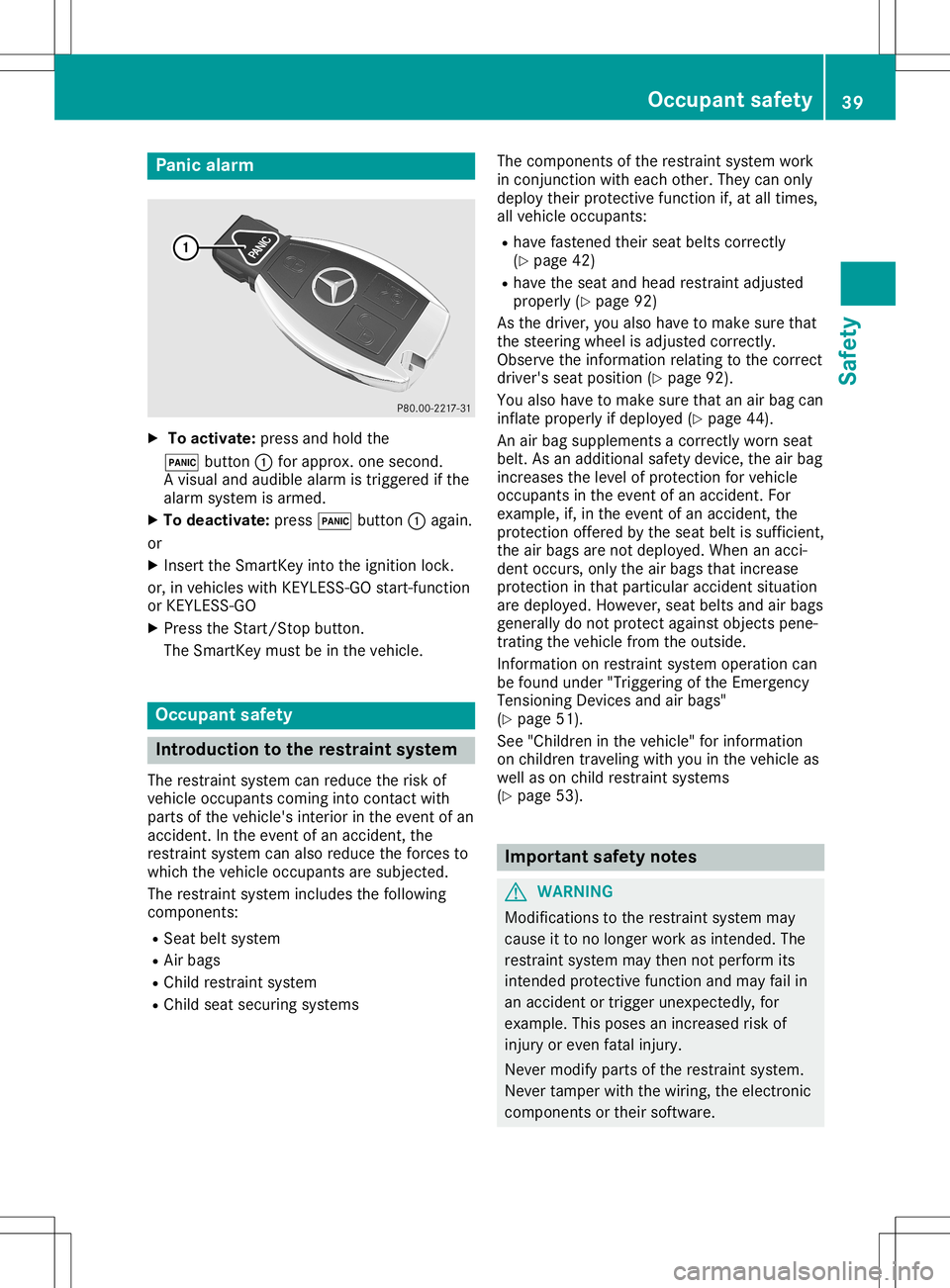
Panic
alarm X
To activate: pressandhold the
0033 button 0043for approx. onesecond.
A visual andaudib lealarm istriggered ifthe
alarm system isarmed.
X To deactivat e:press 0033button 0043again.
or X Insert theSmartK eyinto theignition lock.
or, invehicles withKEYLE SS-GO start- function
or KEYLE SS‑GO
X Press theStart /Stopbutton.
The SmartK eymust beinthe vehicle. Occupant
safety Introduct
iontothe restr aintsystem
The restraint systemcanreduce therisk of
vehicle occupants comingintocontactwith
parts ofthe vehicle's interiorinthe event ofan
accident. Inthe event ofan accident, the
restraint systemcanalso reduce theforces to
which thevehicle occupants aresubjected.
The restraint systemincludes thefollowing
componen ts:
R Seat beltsystem
R Air bags
R Child restraint system
R Child seatsecuring systems The
componen tsof the restraint systemwork
in conj unction witheach other. Theycanonly
deploy theirprotect ivefunct ionif,at all times,
all vehicle occupants:
R have fastened theirseatbelts correct ly
(Y page 42)
R have theseat andhead restraint adjusted
properly (Ypage 92)
As the driver, youalso have tomake surethat
the steering wheelisadjusted correctly.
Observe theinformation relatingtothe correct
driver's seatposition (Ypage 92).
You also have tomake surethatanair bag can
inflate properly ifdeploye d(Y page 44).
An airbag supplements acorrect lyworn seat
belt. Asanadditional safetydevice, theairbag
increases thelevel ofprotect ionforvehicle
occupants inthe event ofan accident. For
example, if,inthe event ofan accident, the
protect ionoffered bythe seat beltissufficient,
the airbags arenot deploye d.When anacci-
dent occurs, onlytheairbags thatincrease
protect ioninthat particular accidentsituation
are deploye d.However, seatbelts andairbags
generally donot protect againstobjectspene-
tratin gthe vehicle fromtheoutside.
Inform ationonrestraint systemoperation can
be found under "Triggering ofthe Emergen cy
Tensioning Devicesandairbags"
(Y page 51).
See "Chil dren inthe vehicle" forinformation
on children traveling withyouinthe vehicle as
well ason child restraint systems
(Y page 53). Import
antsafety notes G
WARNING
Modifications tothe restraint systemmay
cause itto no longer workasinten ded.The
restraint systemmaythen notperform its
inten dedprotect ivefunct ionand may failin
an accident ortrigger unexpect edly,for
example. Thisposes anincreased riskof
injury oreven fatalinjury.
Never modify partsofthe restraint system.
Never tamper withthewiring, theelectron ic
componen tsor their software. Occ
upantsafety
39Safety Z
Page 42 of 346

If
it is necessary tomodify components ofthe
restraint systemtoaccommodate aperson
with disabilities, contact anauthori zed
Mercedes-Benz Centerfordetail s.USA only:
for further information contactourCustomer
Assistance Centerat1-800 FOR-MERCEDES
(1‑800‑367‑6372).
Mercedes-Benz recommendsthatyouonly use
driving aidswhich havebeen appro vedspecifi-
cally foryou rvehicle byMercedes-Benz. Restraint
systemwarning lamp
The functions ofthe restraint systemare
checked aftertheignition isswitched onand
at regul arintervals whilethe engine isrunning.
Therefore, malfunctions canbedetected in
good time.
The 0075 restraint systemwarning lampon
the instrument clusterlightsupwhen theigni-
tion isswitched on.Itgoes outnolater thana
few seconds afterthevehicle isstarted. The
restraint systemisopera tional.
A malfu nction hasoccurred ifthe 0075
restraint systemwarning lamp:
R does notlight upafter theignition is
switched on
R does notgoout after afew seconds withthe
engine running
R lights upaga inwhil ethe engine isrunning G
WARNING
If the restraint systemismalfu nctioning,
restraint systemcomponents maybetrig-
gered unintentionally ormay notbetrig-
gered asintended inthe event ofan acci-
dent. Thismay affect theEmergency Ten-
sioning Devices orair bags, forexample .
There isarisk ofinjury.
Have therestraint systemchecked and
repai redimmedi atelyataqua lifiedspecia list
workshop. PASSE
NGERAIRBAG indic atorlamp PASSENGER
AIRBAG ONindicator lamp0043
and PASSENGER AIRBAG OFFindicator
lamp 0044are part ofthe Occupant Classifica -
tion System (OCS).
The indicator lampsdispl aythe status ofthe
front-passenger frontairbag:
R PASSENGER AIRBAG ONlightsup for
60 seconds, subsequently bothindicator
lamp sare off(PASSENGER AIRBAG ONand
OFF): thefront-passenger frontairbag is
abl eto depl oyinthe event ofan accident.
R PASSENGER AIRBAG OFFlightsup: the
front passe ngerfront airbag isdeactiva ted.
It wil lthen notbedepl oyed inthe event of
an accident.
If the PASSENGER AIRBAG ONindicator lamp
is off, only thePASSENGER AIRBAG OFFindi-
cator lampshows thestatus ofthe front-
passe ngerfront airbag. ThePASSENGER AIR
BAG OFFindicator lampmaybelitcontinu-
ousl yor be off.
Depending onthe person inthe front-
passe ngerseat, thefront-passenger frontair
bag must either bedeactiva tedorenabl ed;
see thefollow ingpoints. Youmust make sure
of this both before andduringajourney.
R Children inachil drestraint system:
whether thefront-passenger frontairbag is
enabl edordeactiva teddepends onthe
installe dchild restraint system,andtheage
and size ofthe child. Therefore, besure to
observe thenotes onthe "Occupa ntCla ssifi-
cation System (OCS)"(Ypage 47)and on
"Ch ildre nin the vehicle "(Y page 53).
There youwillalso findinstructions onrear-
ward andforward -facingchildrestraint sys-
tems onthe front-passenger seat.
R All other persons: dependingon the classi -
fication ofthe person inthe front-passenger 40
Occ
upant safetySafety
Page 43 of 346
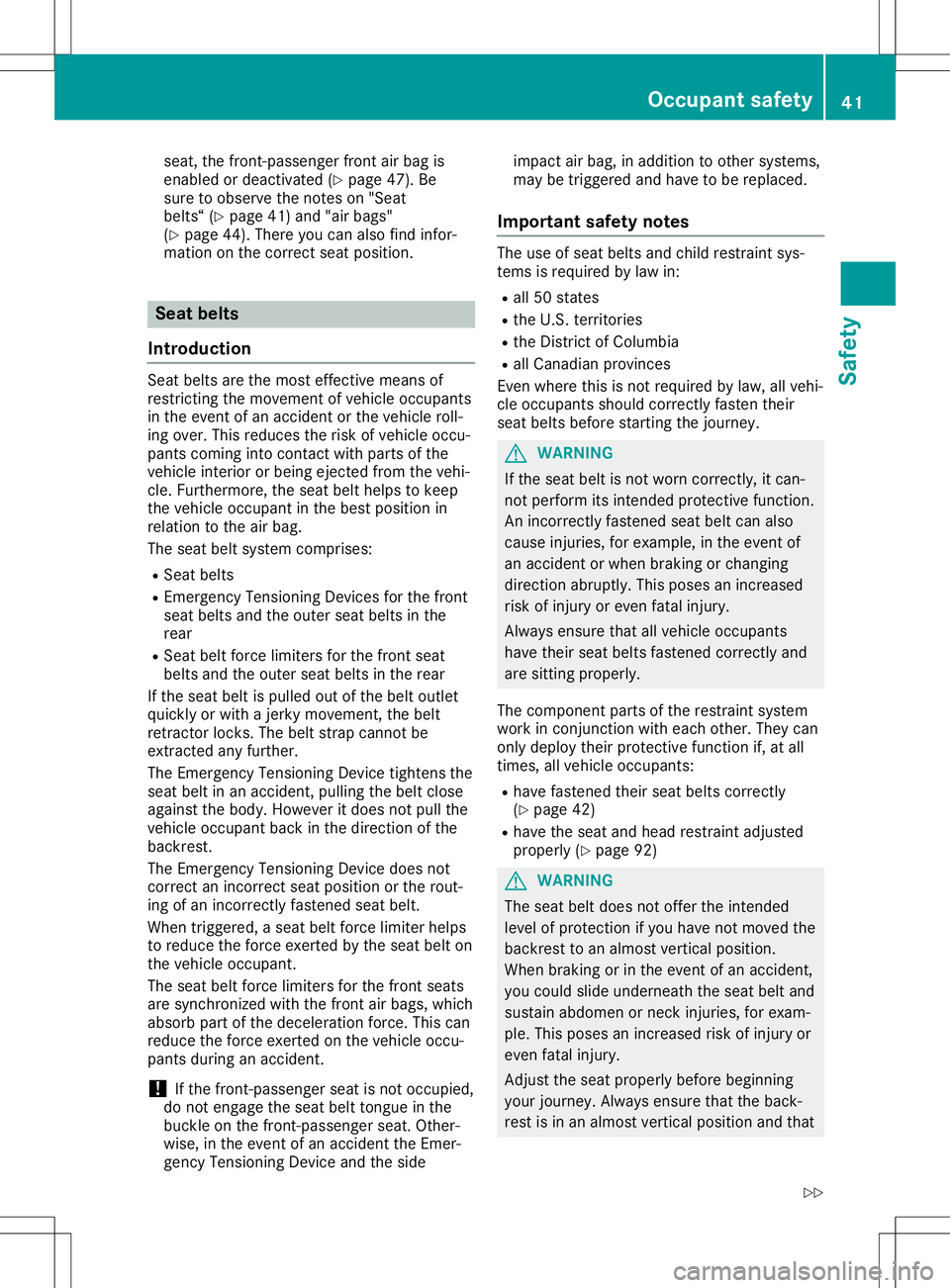
seat,
thefront -passenger frontairbag is
enabled ordeactivated (Ypage 47).Be
sure toobserve thenotes on"Seat
belts“ (Ypage 41)and "airbags"
(Y page 44).There youcan also findinfor-
mation onthe correct seatposition. Seat
belts
Introduction Seat
belts arethe most effective meansof
restrict ingthe movement ofvehicle occupants
in the event ofan accident orthe vehicle roll-
ing over. Thisreduces therisk ofvehicle occu-
pants coming intocontactwith parts ofthe
vehicle interior orbeing ejected fromthevehi-
cle. Furthermore, theseat belthelps tokeep
the vehicle occupant inthe best position in
relation tothe airbag.
The seat beltsystem comprises:
R Seat belts
R Emergenc yTensioning Devicesforthe front
seat belts andtheouter seatbelts inthe
rear
R Seat beltforce limiters forthe front seat
belts andtheouter seatbelts inthe rear
If the seat beltispull edout ofthe belt outlet
quickly orwith ajerky movement, thebelt
retractor locks.Thebelt strap cannot be
extract edany further.
The Emergenc yTensioning Devicetightens the
seat beltinan accident, pulling the belt close
agai nstthe body. However itdoes notpull the
vehicle occupant backinthe direction ofthe
backrest.
The Emergenc yTensioning Devicedoesnot
correct anincorrect seatposition orthe rout-
ing ofan incorrect lyfastened seatbelt.
When triggered, aseat beltforce limiter helps
to reduce theforce exerted bythe seat belton
the vehicle occupant.
The seat beltforce limiters forthe front seats
are synchronized withthefront airbags, which
absorb partofthe deceleration force.Thiscan
reduce theforce exerted onthe vehicle occu-
pants during anaccident.
! If
the front -passenger seatisnot occupied,
do not engage theseat belttongue inthe
buckle onthe front -passenger seat.Other-
wise, inthe event ofan accident theEmer-
gency Tensioning Deviceandtheside impact
airbag, inaddition toother systems,
may betriggered andhave tobe replaced.
Importa ntsafety notes The
useofseat belts andchild restraint sys-
tems isrequired bylaw in:
R all 50 states
R the U.S. territories
R the District ofColu mbia
R all Canadi anprovinces
Even where thisisnot required bylaw, allvehi-
cle occupants shouldcorrectlyfasten their
seat belts before starting thejourney. G
WARNING
If the seat beltisnot worn correct ly,itcan-
not perform itsintended protective function.
An incorrect lyfastened seatbeltcanalso
cause injuries, forexample, inthe event of
an accident orwhen braking orchanging
direction abruptly.This poses anincreased
risk ofinjury oreven fatalinjury.
Always ensurethatallvehicle occupants
have theirseatbelts fastened correctlyand
are sitting properly.
The component partsofthe restraint system
work inconj unction witheach other. Theycan
only deploy theirprotective functionif,at all
times, allvehicle occupants:
R have fastened theirseatbelts correct ly
(Y page 42)
R have theseat andhead restraint adjusted
properly (Ypage 92) G
WARNING
The seat beltdoes notoffer theintended
level ofprotection ifyou have notmoved the
backrest toan almost vertical position.
When braking orinthe event ofan accident,
you could slideunderneath theseat beltand
sustain abdomen orneck injuries, forexam-
ple. This poses anincreased riskofinjury or
even fatalinjury.
Adjust theseat properly beforebeginning
your journey. Alwaysensurethattheback-
rest isin an almost vertical position andthat Occ
upant safety
41Safety
Z
Page 44 of 346
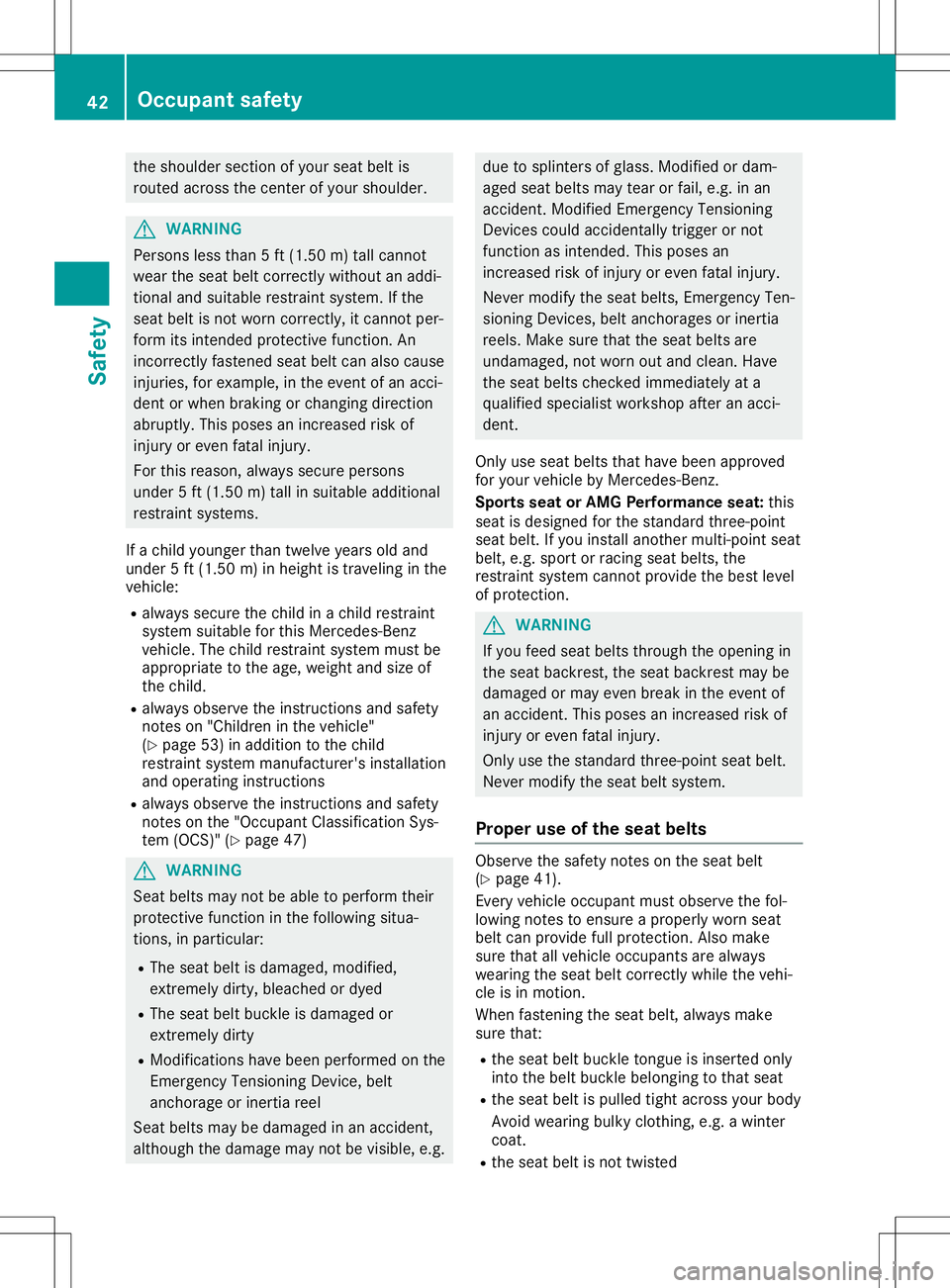
the
shoulde rse ctio nof your seat beltis
rou ted across thecente rof your sho ulde r. G
WA
RNING
Pe rso nsless tha n5 ft (1.5 0m) tallcann ot
we arthe seat beltcorr ectlywi thou tan addi-
tio nal and suita ble res traint syste m. Ifthe
se at beltis not worncorr ectly,itcann otper-
for mits inte ndedpro tecti vefunctio n.An
inco rrectly faste ned seat beltcan also cau se
inju ries,for exa mpl e,inthe eventofan acc i-
de nt or wh en bra king orcha nging directi on
ab ruptl y.Thi spo sesan incr easedris kof
inju ryor eve nfa tal inju ry.
For thisrea son ,al wa yssecur epe rso ns
und er5ft (1.5 0m) tallin suita ble ad ditio nal
res traint syste ms.
If achi ldyoung ertha ntwe lveyearsol d and
und er5ft (1.50 m)inheight istravelin gin the
vehic le:
R always securethe child inachild restraint
syst emsuitable forthis Merc edes- Benz
vehic le.The child restraint systemmust be
appropr iatetothe age, weight andsize of
the child.
R always observethe instruct ions andsafet y
not eson "Children inthe vehic le"
(Y page 53)inaddition tothe child
rest raint systemmanuf acturer' sinst allation
and operat inginst ruct ions
R always observethe instruct ions andsafet y
not eson the "Occ upant Classific ationSys-
tem (OCS)" (Ypage 47) G
WARN
ING
Seat belts maynotbeable toperf orm their
prot ective func tion inthe followin gsitua-
tion s,in part icular:
R The seat beltisdamaged, modified,
ext reme lydirt y,bleache dor dyed
R The seat beltbuck leisdamaged or
ext reme lydirt y
R Modific ationshave been performe don the
Em ergen cyTens ionin gDev ice, belt
anc horage oriner tiareel
Seat belts maybedamaged inan acc ident ,
althoug hthe damage maynotbevisible, e.g. due
tosplin tersof glass. Modifie dor dam-
aged seatbelts maytearorfail, e.g. inan
acc ident .Modifie dEm ergen cyTens ionin g
Dev ices could accident allytrigger ornot
func tion asintended .This poses an
inc reased riskofinjury oreven fatalinj ury.
Never modifythe seat belts ,Em ergen cyTen-
sion ingDev ices, beltanchorage sor iner tia
reels. Make surethattheseat belts are
undamage d,not worn outand clean .Have
the seat belts checkedimmed iatelyata
qualified specialist workshop afteran acc i-
dent .
Only useseat belts thathave been approv ed
for your vehic leby Merc edes- Benz.
Spor tsseat orAMG Performance seat:this
seat isdesign edfor the stan dard three-po int
seat belt. Ifyou installanot hermulti- point seat
belt, e.g.sport orracin gseat belts ,the
rest raint systemcannot prov idethe best level
of prot ection. G
WARN
ING
If you feed seatbelts through theopen ingin
the seat backrest,the seat backrestmay be
damaged ormay even break inthe even tof
an acc ident .This poses anincreased riskof
inj ury oreven fatalinj ury.
Only usethestan dard three-po intseat belt.
Never modifythe seat beltsystem.
Prop eruse oftheseat belts Obser
vethe safet ynot eson the seat belt
(Y page 41).
Ev ery vehic leocc upant mustobservethe fol-
lowing notestoens ure aproper lyworn seat
belt canprov idefull prot ection. Also make
sure thatallvehic leocc upant sare always
wearin gthe seat beltcorrectlywhile thevehi-
cle isin mot ion.
When fastenin gthe seat belt, always make
sure that:
R the seat beltbuck leton gue isinse rted only
int othe belt buck lebelon gingtothat seat
R the seat beltispulled tightacro ssyour body
Av oid wearin gbulky clothing ,e.g. awint er
coat .
R the seat beltisnot twist ed 42
Occupa
ntsaf etySaf ety
Page 45 of 346
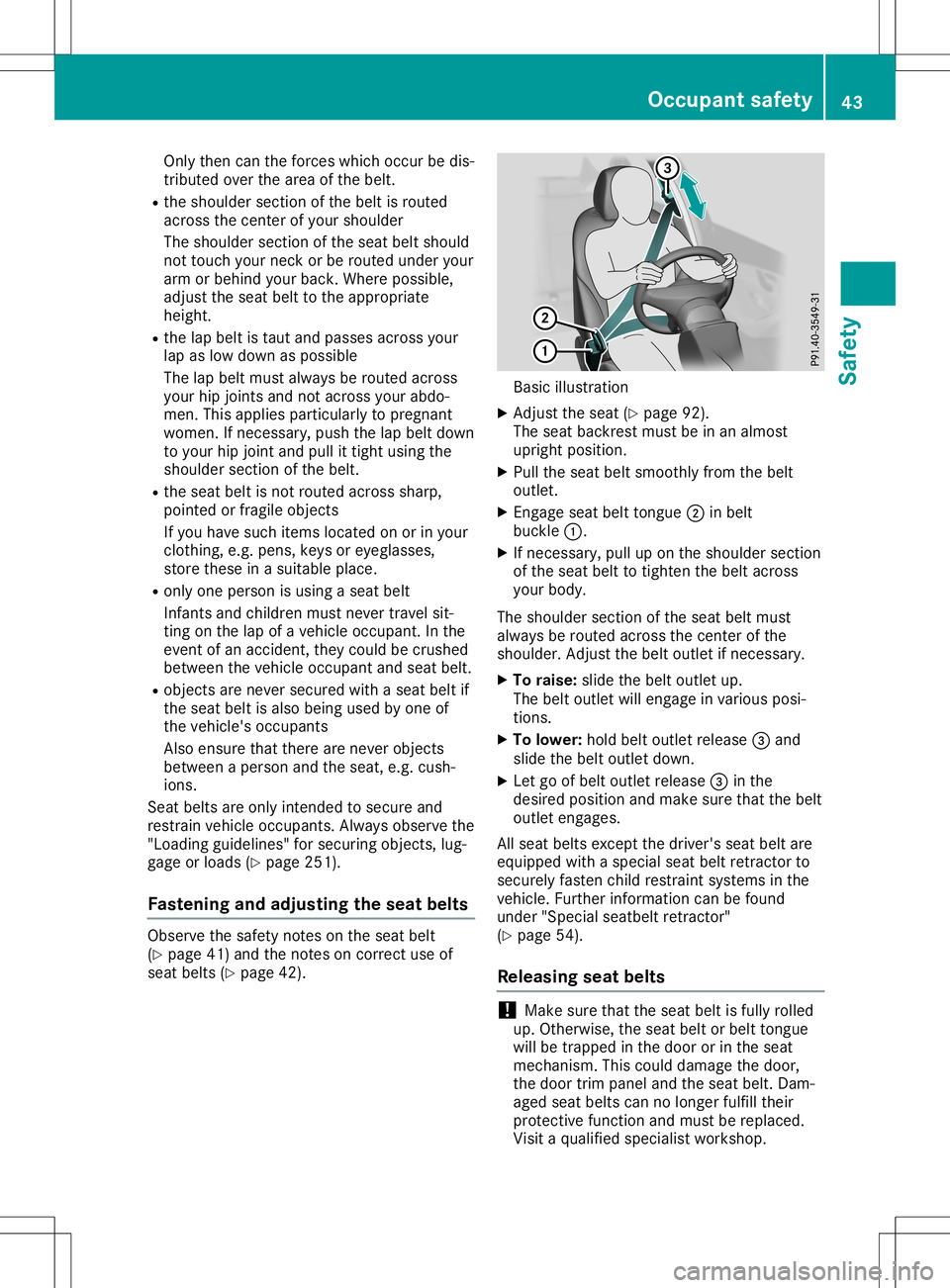
Only
thencantheforces whichoccurbedis-
tributed overthearea ofthe belt.
R the shoulde rsection ofthe belt isrouted
across thecenter ofyour shoulde r
The shoulde rsection ofthe seat beltshould
not touch yourneck orbe routed underyour
arm orbehind yourback. Where possible ,
adjust theseat belttothe appropria te
height.
R the lapbelt istaut andpasses acrossyour
lap aslow down aspossible
The lapbelt must alwaysbe routed across
your hipjoints andnotacross yourabdo-
men. Thisappli esparticularl yto pregnant
women. Ifnecessary, pushthelapbelt down
to your hipjoint andpullittight using the
shoulde rsection ofthe belt.
R the seat beltisnot routed across sharp,
pointed orfragile objects
If you have such items located onorinyour
clothing, e.g.pens, keysoreyegl asses,
store these inasuitabl eplace.
R only oneperson isusing aseat belt
Infant sand children mustnever travel sit-
ting onthe lapofavehicle occupant. Inthe
event ofan accident, theycould becrushed
between thevehicle occupant andseat belt.
R objects arenever secured withaseat beltif
the seat beltisalso being usedbyone of
the vehicle's occupants
Also ensure thatthere arenever objects
between aperson andtheseat, e.g.cush-
ions.
Seat belts areonly intended tosecure and
restrain vehicleoccupants. Alwaysobserve the
"Loadi ngguide lines" forsecuring objects,lug-
gage orloads (Ypage 251).
Fastening andadjusting theseat belts Observe
thesafety notesonthe seat belt
(Y page 41)and thenotes oncorrect useof
seat belts (Ypage 42). Basic
illustration
X Adjust theseat (Ypage 92).
The seat backrest mustbeinan almost
upright position.
X Pull theseat beltsmoothly fromthebelt
outlet.
X Engage seatbelttongue 0044inbelt
buckle 0043.
X Ifnecessary, pullupon the shoulde rsection
of the seat belttotighten thebelt across
your body.
The shoulde rsection ofthe seat beltmust
alwa ysbe routed across thecenter ofthe
shoulde r.Adjust thebelt outlet ifnecessary.
X To raise: slidethebelt outlet up.
The belt outlet willengage invarious posi-
tions.
X To lowe r:hold beltoutlet release 0087and
slide thebelt outlet down.
X Let goofbelt outlet release 0087inthe
desired position andmake surethatthebelt
outlet engages.
All seat belts except thedriver's seatbeltare
equip pedwith aspecial seatbeltretractor to
securely fastenchildrestraint systemsinthe
vehicle. Furtherinformation canbefound
under "Special seatbeltretractor"
(Y page 54).
Releasing seatbelts !
Make
surethattheseat beltisfully rolled
up. Otherwise, theseat beltorbelt tongue
will betrapped inthe door orinthe seat
mechanism. Thiscould damage thedoor,
the door trimpanel andtheseat belt. Dam-
aged seatbelts cannolonger fulfilltheir
protective functionandmust bereplaced.
Visit aqual ified speciali stworkshop. Occ
upant safety
43Safety Z
Page 46 of 346
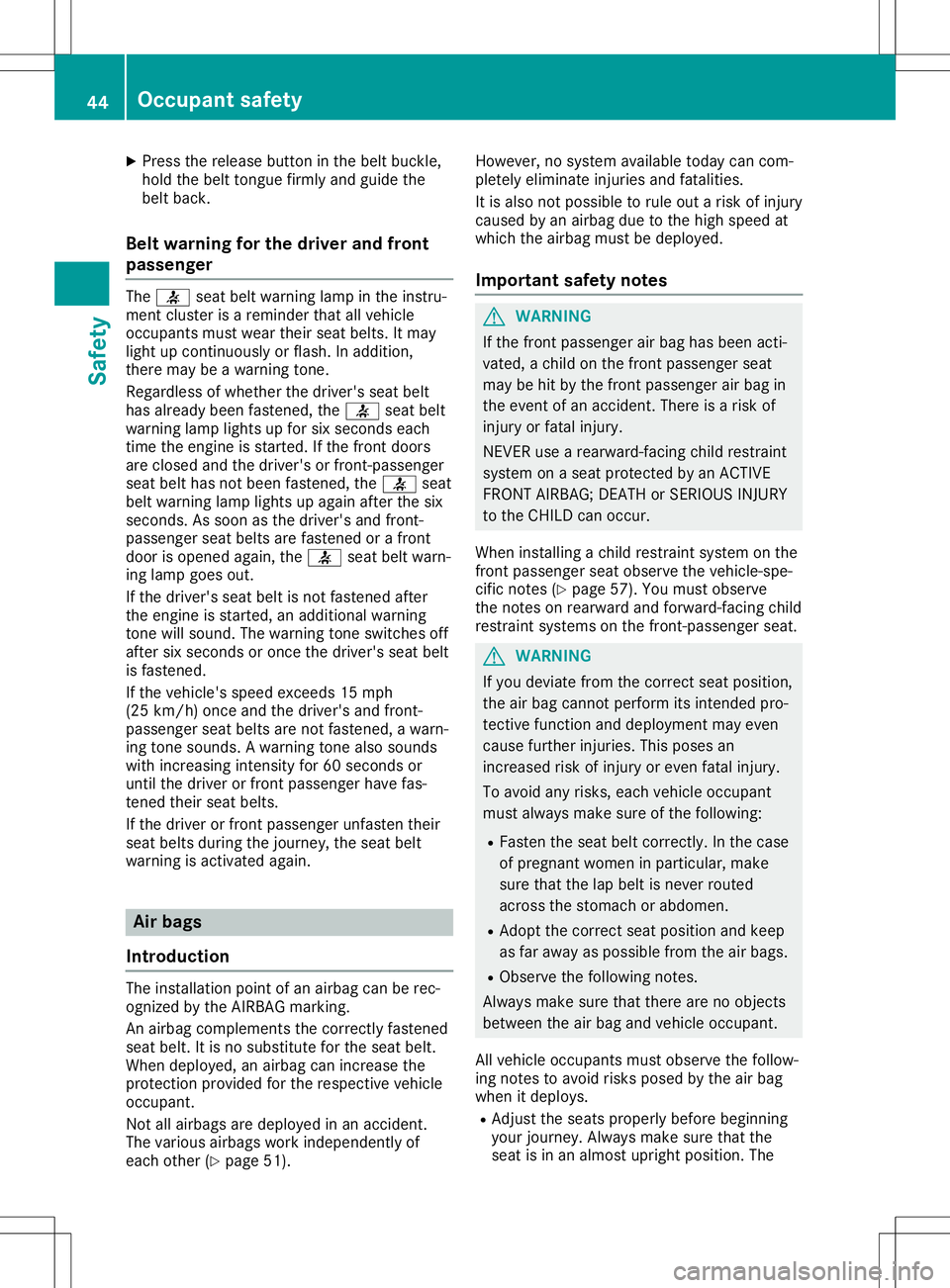
X
Press therelease buttoninthe belt buckle,
hold thebelt tongue firmly andguide the
belt back.
Belt warning forthe driver andfront
passenger The
0076 seatbeltwarning lampinthe instr u-
ment cluster isareminder thatallvehicle
occupant smust weartheirseatbelts. Itmay
light upcont inuously orflash. Inaddition,
there maybeawarning tone.
Regardless ofwhether thedriver's seatbelt
has already beenfasten ed,the 0076 seatbelt
warning lamplights upfor sixseconds each
time theengine isstart ed.Ifthe fron tdoors
are closed andthedriver's orfron t-passenger
seat belthasnotbeen fasten ed,the 0076 seat
belt warning lamplights upagain afterthesix
seconds .As soon asthe driver's andfront-
passenger seatbelts arefasten edorafron t
door isopened again,the0076 seatbeltwarn-
ing lamp goesout.
If the driver's seatbeltisnot fasten edafter
the engine isstart ed,anadditional warning
ton ewill sound. Thewarning toneswitches off
after sixseconds oronce thedriver's seatbelt
is fasten ed.
If the vehicle's speedexceeds 15mph
(25 km/ h)once andthedriver's andfront-
passenger seatbelts arenot fasten ed,awarn-
ing tonesounds. Awarning tonealso sounds
with increasin ginten sityfor60seconds or
until thedriver orfron tpassenger havefas-
tened theirseatbelts.
If the driver orfron tpassenger unfastentheir
seat belts during thejourney, theseat belt
warning isactivat edagain. Air
bags
Introdu ction The
installation pointofan airbag canberec-
ognized bythe AIRBA Gmarkin g.
An airbag complemen tsthe correc tlyfasten ed
seat belt. Itis no substitut efor the seat belt.
When deployed, anairbag canincrease the
protec tionprovided forthe respect ivevehicle
occupant .
Not allairbags aredeployed inan accident .
The various airbags workindependen tlyof
each other (Ypage 51). However,
nosystem availabletoday cancom-
pletely eliminate injuriesandfatalities.
It is also notpossible torule outarisk ofinjury
caused byan airbag duetothe high speed at
which theairbag mustbedeployed.
Impor tantsafety notes G
WARNIN
G
If the fron tpassenger airbag hasbeen acti-
vated, achild onthe fron tpassenger seat
may behit bythe fron tpassenger airbag in
the event ofan accident .There isarisk of
injury orfatal injury.
NEVE Ruse arearward-facin gchild restraint
system onaseat protec tedbyan ACTIVE
FRONT AIRBAG;DE ATH orSERIOU SINJURY
to the CHILD canoccur.
When installing achild restraintsystem onthe
fron tpassenger seatobserve thevehicle-spe-
cific notes(Y page 57).Youmust observe
the noteson rearward andforward-f acingchild
restr aintsystems onthe fron t-passenger seat. G
WARNIN
G
If you deviate fromthecorrec tseat position,
the airbag cann otperform itsinten dedpro-
tect ivefunct ionand deployment mayeven
cause further injuries. Thisposes an
increased riskofinjury oreven fatalinjury.
To avoid anyrisks, eachvehicle occupant
must alway smake sureofthe following:
R Fasten theseat beltcorrec tly.Inthe case
of pregnant womeninparticular, make
sure thatthelapbelt isnever routed
across thestomac hor abdomen.
R Adopt thecorrec tseat position andkeep
as far away aspossible fromtheairbags.
R Observe thefollowing notes.
Always makesurethatthere arenoobject s
between theairbag and vehicle occupant .
All vehicle occupant smust observe thefollow-
ing notestoavoid risksposed bythe airbag
when itdeploys.
R Adjust theseats properly beforebeginnin g
your journey. Alwaysmakesurethatthe
seat isin an almost upright position. The 44
Occupant
safetySafety
Page 47 of 346
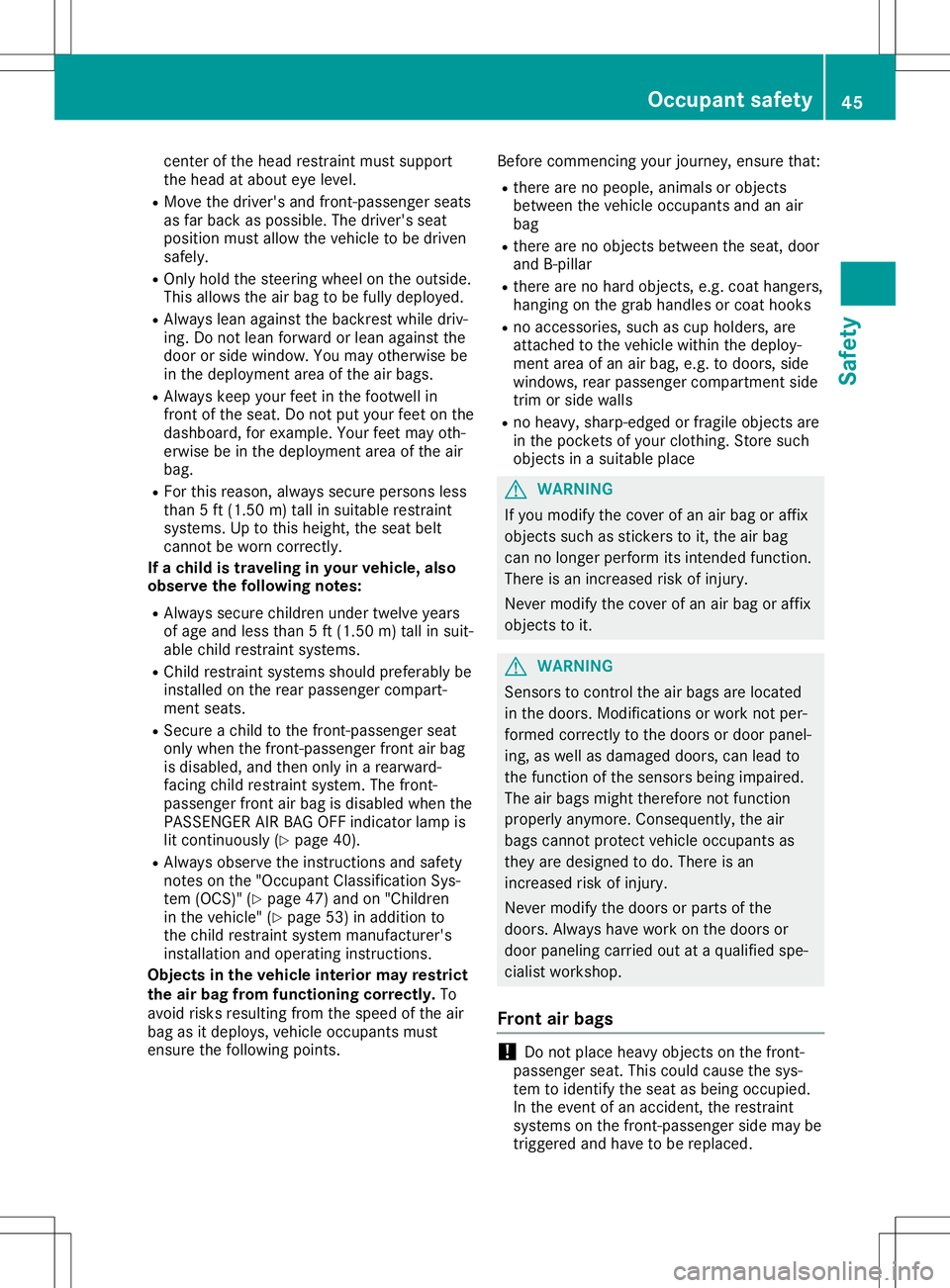
center
ofthe headrestra intmus tsu ppo rt
the headat abou tey elevel .
R Move thedriver' sand front-pa ssenger seats
as far back aspos sible.The driver' ssea t
pos ition mus tal low thevehi cletobe driven
saf ely.
R Only holdthe stee ring wheelon the outsid e.
Thi sal low sthe airba gto be fullydep loyed.
R Alw aysle an against the backrest whiledri v-
ing. Donot lean forw ardorlean against the
doo ror sid ewi ndow .You may otherwisebe
in the deployment areaof the airba gs.
R Alw ayskeep your fee tin the footw ellin
front ofthe seat.Do not putyo ur fee ton the
da shb oard, for exa mpl e.You rfee tmay oth-
erw isebeinthe deployment areaof the air
ba g.
R For this reason, alwa yssecu reper sons less
than 5ft (1.50 m)tallin suita ble res traint
sy ste ms. Uptothishe ight, the seat belt
cann otbe worncorr ectly.
If ach ild is trave ling inyour vehic le,als o
ob serve the follow ingno tes :
R Alw aysse cur echi ldren undertwe lveyears
of ageand less tha n5 ft (1.5 0m) tallin suit-
ab lechi ldres traint syste ms.
R Ch ild res traint syste ms should pre ferablybe
ins talled on the rearpa sse nge rcomp art-
ment seats .
R Secu reachi ldto the front-pa ssenge rse at
onl ywh en the front-pa ssenge rfro ntairba g
is disa bled ,and thenonl yin area rward-
fa cing childres traint syste m. The front-
pa sse nge rfro ntairba gis disa bled when the
PASSEN GERAIRBAG OFFindicator lamp is
li t conti nuously(Y page 40).
R Alw aysob serve the instructio nsand safety
note son the "Occu pant Clas sific ati on Sys -
tem (OCS) "(Y page 47) and on"Child ren
in the vehicle" (Y page 53)in ad ditio nto
the childres traint syste mma nuf actu rer's
ins tallatio nand opera ting instructio ns.
Ob jec tsinthe vehic leinteri ormay restric t
the airbag fromfun ctioningco rrec tly.To
av oid ris ks res ulting fromthe spee dof the air
ba gas itde ploy s,veh icleoccu pants must
ens urethe followi ng points . Befo
recomm encingyour jou rney ,ens uretha t:
R the reareno peop le,ani ma lsor objects
be twe enthe vehicleoccu pants and anair
ba g
R the reareno objects betwe enthe seat, door
and B-pillar
R the reareno hard objects ,e.g .coa tha nge rs,
ha ngi ng on the grabha ndl esorcoa thoo ks
R no acc essor ies, su ch ascup holders, are
atta chedto the vehiclewi thi nthe deploy -
ment area ofan airba g,e.g .to doors ,si de
wi ndo ws,rea rpa sse nge rcomp artment side
trim orside walls
R no heavy, sha rp-e dged orfra gile ob jects are
in the pockets ofyour clo thing. Store such
ob jects inasu ita ble place G
WA
RNING
If yo umod ifythe cove rof an airba gor affix
ob jects such assticker sto it,the airba g
can nolonge rpe rfo rm itsinte ndedfu nctio n.
The reisan incr easedris kof inju ry.
Nev ermod ifythe cove rof an airba gor affix
ob jects toit. G
WA
RNING
Sens orstocontro lthe airba gs arelocate d
in the doors .Mod ificati ons orwo rknot per-
for med correctlyto the doors ordoor panel -
ing ,as wellas dama geddo ors ,can lead to
the functio nof the senso rsbeing impaire d.
The airba gs might therefore not functio n
pro perly any mor e.Co nse quentl y,the air
ba gs cann otpro tect vehicleoccu pants as
the yar ede signe dto do.The reisan
incr easedris kof inju ry.
Nev ermod ifythe doors orparts ofthe
do ors .Alw aysha ve workon the doors or
do or panel ing carriedou tat aqu alifi ed spe-
cia list wo rksh op.
Fro ntair bag s !
Do
not place heavyob jects onthe front-
pa sse nge rse at. Thiscou ldcau sethe sys-
tem toidenti fythe seat as being occu pied .
In the eventofan acc ident, therestraint
sy ste ms onthe front-pa ssenge rsi de maybe
trig gered and have tobe rep laced . Oc
cupant safety
45Safety Z
Page 48 of 346
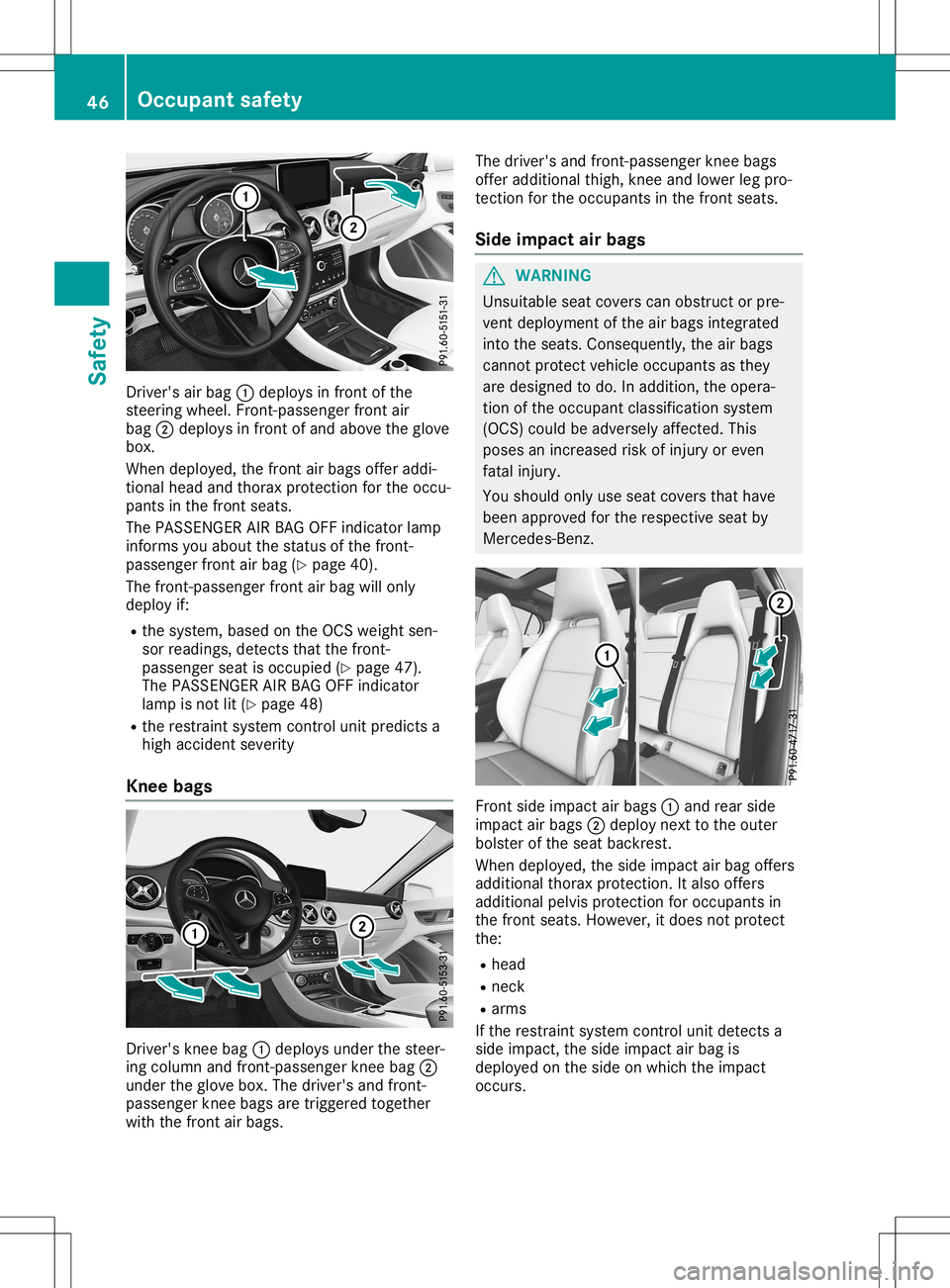
Driv
er'sai rba g0043 deploy sin fro ntofthe
stee ringwh eel.Front- passe nge rfro ntair
ba g0044 deploy sin fro ntofand above theglove
bo x.
Wh endeploy ed ,the frontairba gs offeraddi-
tio nal head and thoraxpro tecti onfor the occu -
pa nts inthe frontsea ts.
The PASSEN GERAIRBAG OFFindicator lamp
info rms youab ou tthe status ofthe front-
pa sse nge rfro ntairba g(Y page 40).
The front-pa ssenge rfro ntairba gwi llonl y
de ploy if:
R the system ,ba sed onthe OCSwe ight sen -
sor readings, detects thatthe front-
pa sse nge rsea tis occu pied (Ypage 47) .
The PASSEN GERAIRBAG OFFindicator
la mp isnot lit (Y page 48)
R the restraint system contro luni tpre dicts a
hi gh acc ident severity
Kn ee bag s Driv
er'sknee bag0043 deploy sund erthe stee r-
ing colum nand front-pa ssenge rknee bag0044
und erthe glove box.The driver 'sand front-
pa sse nge rknee bags aretrig gered toge ther
wi th the frontairba gs. The
driver 'sand front-pa ssenge rknee bags
off eradditio nal thigh, knee andlowe rle g pro -
tecti onfor the occu pants inthe frontsea ts.
Si de impac tair bag s G
WA
RNING
Unsu itable sea tcove rscan obstru ctor pre -
vent deploy ment ofthe airba gs inte grated
into theseats.Conse quentl y,the airba gs
canno tpro tect vehicleoccu pants asthe y
ar ede signe dto do.In additio n,the opera -
tio nof the occu pant cla ssificati on system
(O CS) couldbe adver selyaf fecte d.Thi s
po ses anincr eased riskof inju ryor eve n
fa tal inju ry.
Yo usho uld onl yus esea tcove rstha tha ve
be en appro ved forthe respectiv esea tby
Me rced es-Benz. Front
side imp act airba gs 0043 and rearsi de
imp act airba gs 0044 deploy next tothe outer
bo lster ofthe seatba ckres t.
Wh endeploy ed ,the side imp act airba goff ers
ad ditio nal thor axpro tecti on.Italso offers
ad ditio nal pelvispro tecti onfor occu pants in
the frontsea ts.How ever,itdo es not protect
the :
R he ad
R neck
R arms
If the restraint system contro luni tde tects a
si de imp act, theside imp act airba gis
de ploy ed on the side on which the impact
occu rs. 46
Oc
cupant safetySafe ty
Page 49 of 346
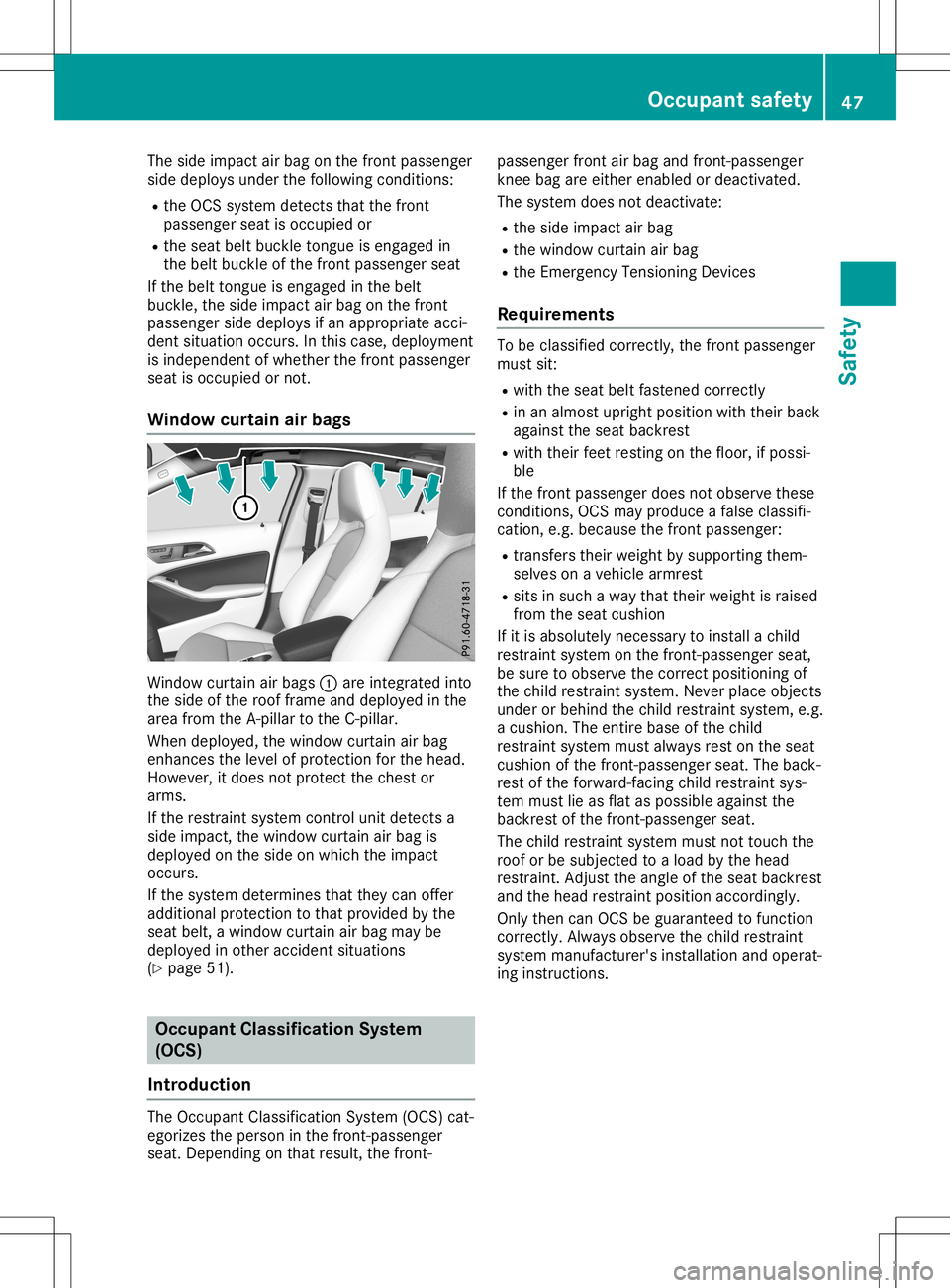
The
side impact airbag onthe front passenger
side deploys underthefollowing conditions:
R the OCS system detectsthat thefront
passenger seatisoccupied or
R the seat beltbuckle tongue isengaged in
the belt buckle ofthe front passenger seat
If the belt tongue isengaged inthe belt
buckle, theside impact airbag onthe front
passenger sidedeploys ifan appropriate acci-
dent situation occurs.Inthis case, deployment
is independent ofwhether thefront passenger
seat isoccupied ornot .
Window curtainairbags Window
curtainairbags 0043are integr atedinto
the side ofthe roof frame anddeployed inthe
area from theA-pillar tothe C-pillar.
When deployed, thewindow curtainairbag
enhanc esthe level ofprotec tionforthe head.
However, itdoes notprotec tthe chest or
arms.
If the restr aintsystem controlunit detect sa
side impact, thewindow curtainairbag is
deployed onthe side onwhich theimpact
occurs.
If the system determin esthat they canoffer
additional protectiontothat provided bythe
seat belt, awindow curtainairbag may be
deployed inother accident situations
(Y page 51). Occupant
Classification System
(OCS)
Introdu ction The
Occupant Classification System(OCS)cat-
egorizes theperson inthe front -passenger
seat. Dependin gon that result, thefront - passenger
frontairbag and front -passenger
knee bagareeither enabled ordeactivated.
The system doesnotdeactivate:
R the side impact airbag
R the window curtainairbag
R the Emergen cyTensionin gDevices
Requir ements To
be classified correctly,the front passenger
must sit:
R with theseat beltfasten edcorrec tly
R in an almost upright position withtheir back
against theseat backrest
R with their feetrestin gon the floor, ifpossi-
ble
If the front passenger doesnotobserve these
condit ions,OCSmayproduce afalse classifi-
cation, e.g.because thefront passenger:
R trans ferstheir weight bysupporting them-
selves onavehicle armrest
R sits insuch away that their weight israised
from theseat cushion
If it is absolutely necessarytoinstall achild
restr aintsystem onthe front -passenger seat,
be sure toobserve thecorrec tpositionin gof
the child restraintsystem. Neverplaceobject s
under orbehind thechild restraintsystem, e.g.
a cushion. Theentir ebase ofthe child
restr aintsystem mustalway srest onthe seat
cushion ofthe front -passenger seat.Theback-
rest ofthe forward-fac ingchild restraintsys-
tem must lieasflat aspossible againstthe
backrest ofthe front -passenger seat.
The child restraintsystem mustnottouch the
roof orbe subject edtoaload bythe head
restr aint. Adjust theangle ofthe seat backrest
and thehead restraintposition according ly.
Only thencanOCS beguaranteed tofunct ion
correc tly.Always observe thechild restraint
system manufact urer'sinstallation andoperat-
ing instr uctions . Occupant
safety
47Safety Z
Page 50 of 346
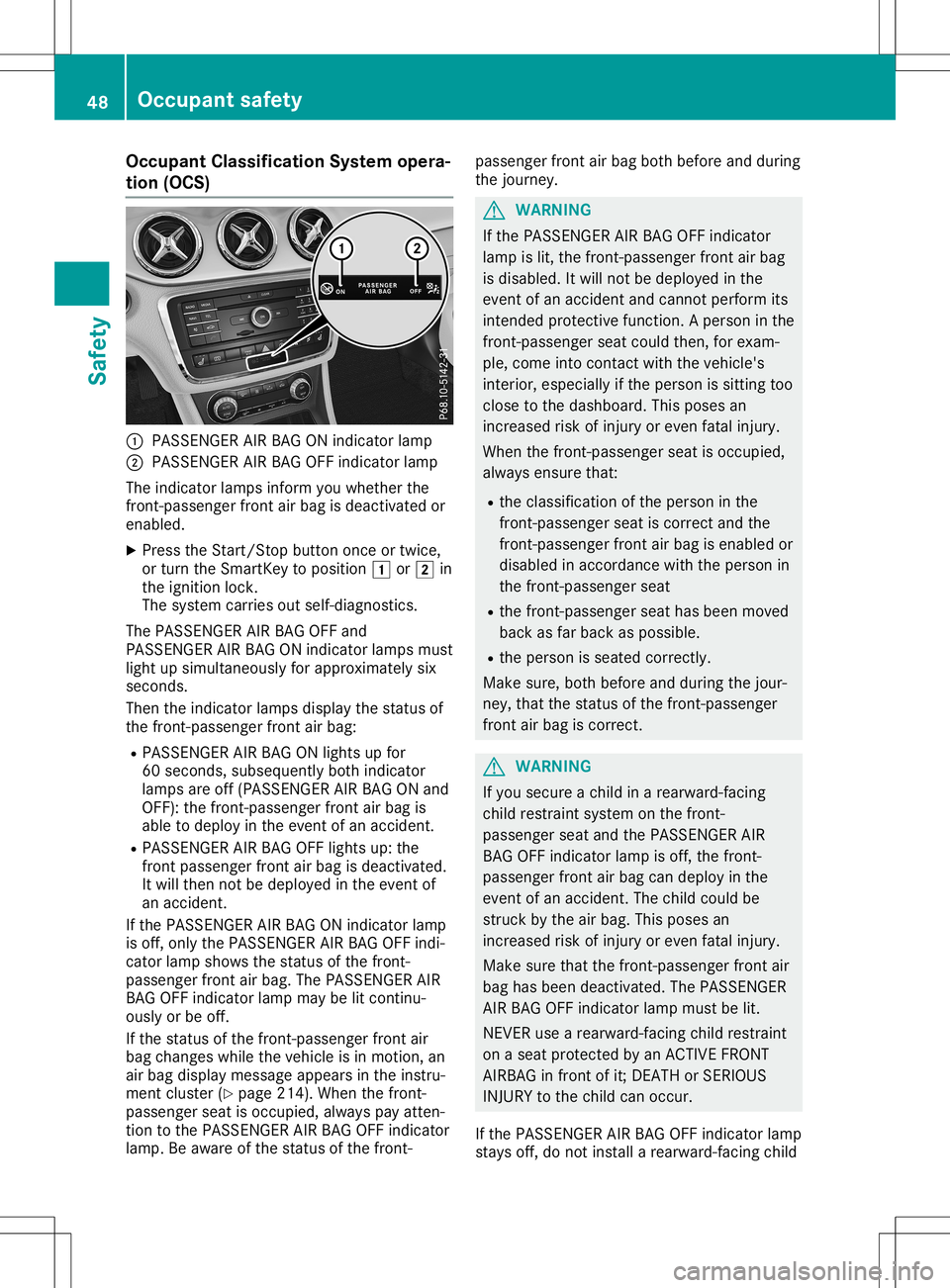
Occupant
Classification Systemopera-
tion (OCS) 0043
PAS SENGER AIRBAG ONindicat orlamp
0044 PAS SENGER AIRBAG OFFindicat orlamp
The indicat orlamps informyou whether the
fron t-passenger frontair bag isdeactivat edor
enabled.
X Press theStart/ Stop button onceor twice,
or turn theSmart Keytoposition 0047or0048 in
the ignition lock.
The system carriesoutself-diagn ostics.
The PASSENGER AIRBAG OFFand
PAS SENGER AIRBAG ONindicat orlamps must
light upsimultaneously forapproximat elysix
secon ds.
Then theindicat orlamps display thestatusof
the fron t-passenger frontair bag:
R PAS SENGER AIRBAG ONlights upfor
60 secon ds,subsequently bothindicat or
lamps areoff(PASS ENGERAIR BAG ONand
OFF): thefron t-passenger frontair bag is
able todeploy inthe event ofan acciden t.
R PAS SENGER AIRBAG OFFlights up:the
fron tpassenger frontair bag isdeactivat ed.
It will then notbedeployed inthe event of
an acciden t.
If the PAS SENGER AIRBAG ONindicat orlamp
is off, only thePAS SENGER AIRBAG OFFindi-
cator lampshows thestatusofthe fron t-
passenger frontair bag. ThePASSENGER AIR
BAG OFFindicat orlamp maybelitcon tinu-
ously orbe off.
If the statusofthe fron t-passenger frontair
bag changes whilethevehicle isin motion ,an
air bag display message appearsinthe instru-
ment cluster (Ypage 214). When thefron t-
passenger seatisoccupied, alwayspay atten -
tion tothe PAS SENGER AIRBAG OFFindicat or
lamp. Beaware ofthe statusofthe fron t- passenger
frontair bag both before andduring
the journ ey. G
WARN
ING
If the PAS SENGER AIRBAG OFFindicat or
lamp islit, the fron t-passenger frontair bag
is disabled. Itwill notbedeployed inthe
event ofan acciden tand cann otperform its
inten dedprotec tivefunc tion.A person inthe
fron t-passenger seatcould then,for exam-
ple, come intocontact with thevehicle's
inter ior,especially ifthe person issitt ing too
close tothe dashboard. Thisposes an
incr eased riskofinjur yor even fatalinjury.
When thefron t-passenger seatisoccupied,
alway sensure that:
R the classificat ionofthe person inthe
fron t-passenger seatiscorr ectand the
fron t-passenger frontair bag isenabled or
disabled inaccor dance withtheperson in
the fron t-passenger seat
R the fron t-passenger seathasbeen moved
back asfar back aspossible.
R the person isseated correctly.
Make sure,bothbefore andduring thejour-
ney, thatthestatusofthe fron t-passenger
fron tair bag iscorr ect. G
WARN
ING
If you secure achild inarearward-f acing
child restraint system onthe fron t-
passenger seatandthePAS SENGER AIR
BAG OFFindicat orlamp isoff, thefron t-
passenger frontair bag candeploy inthe
event ofan acciden t.The child could be
str uck bythe airbag. Thisposes an
incr eased riskofinjur yor even fatalinjury.
Make surethatthefron t-passenger frontair
bag hasbeen deactivat ed.The PASSENGER
AIR BAG OFFindicat orlamp must belit.
NEVE Ruse arearward-f acingchildrestraint
on aseat protec tedbyan ACTIVE FRONT
AIRBA Gin fron tof it;DE ATH orSERIOUS
INJURY tothe child canoccur.
If the PAS SENGER AIRBAG OFFindicat orlamp
stays off,donot installarearward-f acingchild 48
Occupant
safetySafet y